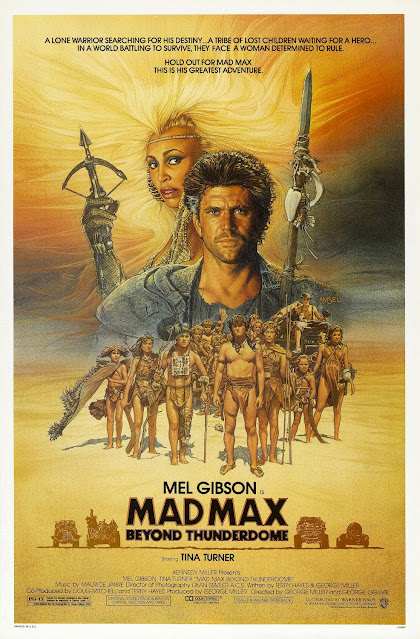In the post-apocalyptic settlement Bartertown, a power struggle is underway between Aunty Entity (Tina Turner), the ostensible ruler of the town, and Master (Angelo Rossitto), who runs the refinery which produces the town's energy.
Aunty enlists a stranger, Max (Mel Gibson), to kill Master and his hulking bodyguard Blaster (Paul Larsson).
When Max shows mercy, Aunty exiles him back out into the wasteland.
In the wasteland, Max stumbles into another community, a hidden society dreaming of a mysterious saviour who can save them...
AKA Mad Max goes mainstream.
If, like me, your knowledge of Mad Max comes from the Road Warrior and Fury Road, the opening credits will cause whiplash.
We get white on black credits backed by a pop song, Tina Turner’s ‘One of the Living’.
I remember seeing the trailer for this one on the Road Warrior VHS we rented - I think my Dad said it was not good.
What is frustrating about writing about this one is that the things I dislike about this movie are the same as everyone else’s.
There is a broken quality to the story that is hard to shake.
The third act rallies with another car chase, but I felt like we needed more differentiation - the Barter Town and lost children sections are so distinct that I was hoping for another.
The standout element of the movie is Tina Turner as Auntie Entity. On the poster, it seems a little gimmicky. But her casting is a perfect example of how deeply thought out every element of these films is. By casting Turner, George Miller is drawing on her own history and struggles, infusing the character with a sense of non-diegetic weight.
On top of that subtext, Turner brings real rockstar energy that the character needs. She fills up every scene she is in, and matches Gibson for star power - and maybe overwhelms him.
Aunty Entity is also not a warrior - she is more sophisticated in her methods of control. The whole basis of Bartertown is to replace pillaging with trade.
It is a natural evolution from the anarchy the previous movie - people will eventually build standing communities, create infrastructure, and develop rules to live peacefully.
The film is ultimately about two variations of this idea - after Max is exiled from Bartertown, he falls in with The Tribe Who Left, a group of teenagers who are the survivors of a plane which fled the nuclear war and crash-landed.
Left on their own, they have developed their own oral traditions and belief system built around the story of 'Captain Walker', the plane's pilot who left to find help and promised to return. Max's arrival is seen as the prophecy coming true.
Tonally the movie is a mess - the comedic beats and the violence don’t carry the same vein of unpredictable surrealism of the previous movies.
The fact that this movie is no longer the last Mad Max movie helps its ending, making it feel more like the end of specific chapter.
And as with its predecessors, this movie feels like a signpost for the next chapter:
After learning their story, Max takes over the tribe’s home by force and tells them their desire to leave is pointless - there is nothing is out there better than their current home. Fury Road would call back this beat with Max’s final advice to return to the citadel.
The reason why this film feels so different probably has to do with the real-life tragedy which took place before production - George Miller's producing partner and friend Byron Kennedy died in an accident during pre-production.
Miller considered cancelling the film, and then brought on respected Australian theatre director George Ogilvie to co-direct the film. The resulting film feels of a piece with the other entries in terms of their design and world-building, but there is a distance and a lack of energy, as though Miller's pain is ingrained through every frame.
Last year I read Blood, Sweat & Chrome, Kyle Buchanan's oral history on the making of Fury Road, and one of the key themes of the film, which everyone keeps returning to, is the importance of human life.
Despite their violence, that theme can be read through all of the Mad Max movies - and it feels especially poignant in this movie. In the end, Max saves the children.
And unlike the other movies, there is no final showdown with the antagonist. Recognising another survivor, Aunty Entity lets Max go.
Max is back on his own, carving out life wherever he can find it...
Mad Max Beyond Thunderdome deserves another look. While it lacks the drive of the movies around it, there is as much going on under the hood as the films either side of it. And that Tina Turner song is a banger.

No comments:
Post a Comment